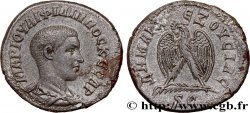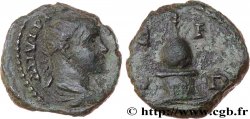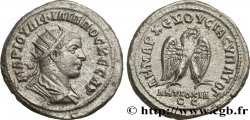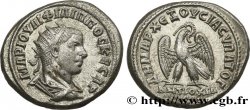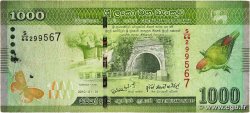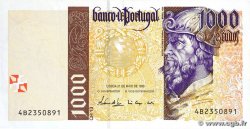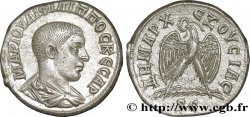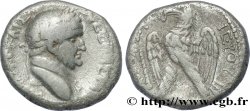bpv_153806 - PHILIPPUS II Tétradrachme syro-phénicien
Nicht verfügbar.
Artikel auf unserem Online-Shop verkauft (2014)
Preis : 180.00 €
Artikel auf unserem Online-Shop verkauft (2014)
Preis : 180.00 €
Type : Tétradrachme syro-phénicien
Datum: 244
Name der Münzstätte / Stadt : Antioche, Syrie, Séleucie et Piérie
Metall : Scheidemünze
Durchmesser : 28,00 mm
Stempelstellung : 7 h.
Gewicht : 11,79 g.
Kommentare zum Erhaltungszustand:
Frappe parfaitement centrée sur un flan exact, surface d’origine préservée mais brillant de frappe terni au revers
N° im Nachschlagewerk :
Pedigree :
Cet exemplaire, qui provient de la trouvaille dite de Jordanie 1930, est le 0333_034 de la base TSP
Vorderseite
Beschreibung Vorderseite Buste tête nue drapé à droite, vu de trois quarts arrière.
Legende des Averses MAR IOULI FILIPPOS KESAR
Übersetzung der Vorderseite (Marcus Julius Philippus césar).
Rückseite
Titulatur der Rückseite S|C À L’EXERGUE.
Beschreibung Rückseite Aigle debout à droite, les ailes déployées, tête et queue à gauche, tenant une couronne feuillée dans son bec, posé sur une palme tige à droite.
Legende des Reverses : DHMARC - EX OUSIAS, (Dhmarcikhs Ex Ousias)
Übersetzung der Rückseite (Revêtu de la puissance tribunitienne / avec l’accord du Sénat).
Kommentare
Suite aux commentaires pertinents de Richard McAlee à propos de son numéro 1009 concernant l'existence de bustes drapés et cuirassés mais aussi de bustes drapés seuls, nous avons divisé le type 333 en deux parties.
Le 333 concerne, suivant une logique chronologique, les bustes drapés seuls qui se définissent par l'épaule qui est ronde et sans ptéryges.
Le 333A suit et concerne les bustes drapés et cuirassés dont l'épaule porte des ptéryges.
Les exemplaires où l'épaule n'est pas visible doivent être classés par comparaison de coins.
Les frappes de Philippe II, comme celles d’Otacilie Sévère d’ailleurs, portent les titres de Philippe. Elles se distinguent entre elles par deux légendes, différents aigles de revers et un portrait à droite ou à gauche.
Après les frappes de l’atelier de Rome au MONVRB, les émissions de Philippe sont réorganisées à Antioche, le SC conservé et l’aigle est posé sur une palme. Le point essentiel est qu’elle sera présente jusqu’aux frappes du troisième consulat (il n’y a pas de frappes du deuxième consulat) puis reviendra pour toutes les émissions de Trajan Dèce avant de disparaître définitivement avec les frappes de Trébonien Galle et la fin des émissions de tétradrachmes.
La palme est un attribut monétaire récurrent à Antioche, soit dans le champ, soit sous les pattes de l’aigle du revers. A-t-elle toujours la même signification ? Impossible de le savoir. Théoriquement, la palme est le corollaire d’une onction, d’une fête, une décoration religieuse largement utilisée (voir la scène de l’arrivée du Christ à Jérusalem), et probablement, comme l’aigle, un symbole religieux œcuménique, destiné à être compris et accepté par tous les habitants de la région.
Le retour du SC, disparu des revers entre 242 et 244, après avoir remplacé à Antioche le Delta Eta apparu en 215, et jamais vu dans un autre atelier officiel, est confirmé. Si nous suivons la logique développée pour ces émissions, il faut croire que ces frappes de Philippe ont reçu l’assentiment (au moins) et le financement (au plus) du sénat d’Antioche. Une gigantesque rançon ayant été payée aux Perses pour abréger la guerre, le propre frère de Philippe étant gouverneur de Syrie, sa propre famille en étant originaire, on peut au moins penser que le Sénat regagna de son importance de l’époque des Sévères. La réputation de Priscus étant de pressurer la population - au point de susciter l’usurpateur Jotapian - on peut aussi penser que le produit de ces spoliations servit à frapper des tétradrachmes au portrait et donc à la gloire de l’Empereur.
On note que les sigma sont gravés en C.
Dans la base TSP maintenue par Michel Prieur, cinquante-cinq exemplaires sont maintenant répertoriés pour ce type dont en musées British Museum, Oxford, ANS (2), Jérusalem et Glasgow.
Following Richard McAlee's insightful comments on his issue 1009 concerning the existence of draped and cuirassed busts, but also of draped busts alone, we have divided type 333 into two parts..
333 concerns, following a chronological logic, the draped busts alone which are defined by the shoulder which is round and without pteryges.
333A follows and concerns draped and armoured busts whose shoulders bear pteryges.
Specimens where the shoulder is not visible should be graded by die comparison.
The coins of Philip II, like those of Otacilia Severus, bear the titles of Philip. They are distinguished from each other by two legends, different reverse eagles and a portrait on the right or left..
After the strikes of the Rome workshop at MONVRB, the issues of Philip were reorganized in Antioch, the SC preserved and the eagle placed on a palm branch. The essential point is that it will be present until the strikes of the third consulate (there are no strikes of the second consulate) then will return for all the issues of Trajan Decius before disappearing definitively with the strikes of Trebonianus Gallus and the end of the issues of tetradrachms.
The palm is a recurring monetary attribute in Antioch, either in the field or under the paws of the eagle on the reverse. Does it still have the same meaning? It's impossible to know.. Theoretically, the palm is the corollary of an anointing, a feast, a widely used religious decoration (see the scene of Christ's arrival in Jerusalem), and probably, like the eagle, an ecumenical religious symbol, intended to be understood and accepted by all the inhabitants of the region..
The return of the SC, which disappeared from the reverses between 242 and 244, after having replaced in Antioch the Delta Eta which appeared in 215, and never seen in another official workshop, is confirmed. If we follow the logic developed for these emissions, we must believe that these strikes of Philip received the assent (at least) and the financing (at most) of the senate of Antioch. A gigantic ransom having been paid to the Persians to shorten the war, Philip's own brother being governor of Syria, his own family being from there, one can at least think that the Senate regained its importance of the time of the Severans. Priscus's reputation for squeezing the population - to the point of giving rise to the usurper Jotapian - we can also think that the product of these spoliations was used to strike tetradrachms with the portrait and therefore to the glory of the Emperor..
Note that the sigmas are engraved in C.
In the TSP database maintained by Michel Prieur, fifty-five examples are now listed for this type, including in the British Museum, Oxford, ANS (2), Jerusalem and Glasgow.
Le 333 concerne, suivant une logique chronologique, les bustes drapés seuls qui se définissent par l'épaule qui est ronde et sans ptéryges.
Le 333A suit et concerne les bustes drapés et cuirassés dont l'épaule porte des ptéryges.
Les exemplaires où l'épaule n'est pas visible doivent être classés par comparaison de coins.
Les frappes de Philippe II, comme celles d’Otacilie Sévère d’ailleurs, portent les titres de Philippe. Elles se distinguent entre elles par deux légendes, différents aigles de revers et un portrait à droite ou à gauche.
Après les frappes de l’atelier de Rome au MONVRB, les émissions de Philippe sont réorganisées à Antioche, le SC conservé et l’aigle est posé sur une palme. Le point essentiel est qu’elle sera présente jusqu’aux frappes du troisième consulat (il n’y a pas de frappes du deuxième consulat) puis reviendra pour toutes les émissions de Trajan Dèce avant de disparaître définitivement avec les frappes de Trébonien Galle et la fin des émissions de tétradrachmes.
La palme est un attribut monétaire récurrent à Antioche, soit dans le champ, soit sous les pattes de l’aigle du revers. A-t-elle toujours la même signification ? Impossible de le savoir. Théoriquement, la palme est le corollaire d’une onction, d’une fête, une décoration religieuse largement utilisée (voir la scène de l’arrivée du Christ à Jérusalem), et probablement, comme l’aigle, un symbole religieux œcuménique, destiné à être compris et accepté par tous les habitants de la région.
Le retour du SC, disparu des revers entre 242 et 244, après avoir remplacé à Antioche le Delta Eta apparu en 215, et jamais vu dans un autre atelier officiel, est confirmé. Si nous suivons la logique développée pour ces émissions, il faut croire que ces frappes de Philippe ont reçu l’assentiment (au moins) et le financement (au plus) du sénat d’Antioche. Une gigantesque rançon ayant été payée aux Perses pour abréger la guerre, le propre frère de Philippe étant gouverneur de Syrie, sa propre famille en étant originaire, on peut au moins penser que le Sénat regagna de son importance de l’époque des Sévères. La réputation de Priscus étant de pressurer la population - au point de susciter l’usurpateur Jotapian - on peut aussi penser que le produit de ces spoliations servit à frapper des tétradrachmes au portrait et donc à la gloire de l’Empereur.
On note que les sigma sont gravés en C.
Dans la base TSP maintenue par Michel Prieur, cinquante-cinq exemplaires sont maintenant répertoriés pour ce type dont en musées British Museum, Oxford, ANS (2), Jérusalem et Glasgow.
Following Richard McAlee's insightful comments on his issue 1009 concerning the existence of draped and cuirassed busts, but also of draped busts alone, we have divided type 333 into two parts..
333 concerns, following a chronological logic, the draped busts alone which are defined by the shoulder which is round and without pteryges.
333A follows and concerns draped and armoured busts whose shoulders bear pteryges.
Specimens where the shoulder is not visible should be graded by die comparison.
The coins of Philip II, like those of Otacilia Severus, bear the titles of Philip. They are distinguished from each other by two legends, different reverse eagles and a portrait on the right or left..
After the strikes of the Rome workshop at MONVRB, the issues of Philip were reorganized in Antioch, the SC preserved and the eagle placed on a palm branch. The essential point is that it will be present until the strikes of the third consulate (there are no strikes of the second consulate) then will return for all the issues of Trajan Decius before disappearing definitively with the strikes of Trebonianus Gallus and the end of the issues of tetradrachms.
The palm is a recurring monetary attribute in Antioch, either in the field or under the paws of the eagle on the reverse. Does it still have the same meaning? It's impossible to know.. Theoretically, the palm is the corollary of an anointing, a feast, a widely used religious decoration (see the scene of Christ's arrival in Jerusalem), and probably, like the eagle, an ecumenical religious symbol, intended to be understood and accepted by all the inhabitants of the region..
The return of the SC, which disappeared from the reverses between 242 and 244, after having replaced in Antioch the Delta Eta which appeared in 215, and never seen in another official workshop, is confirmed. If we follow the logic developed for these emissions, we must believe that these strikes of Philip received the assent (at least) and the financing (at most) of the senate of Antioch. A gigantic ransom having been paid to the Persians to shorten the war, Philip's own brother being governor of Syria, his own family being from there, one can at least think that the Senate regained its importance of the time of the Severans. Priscus's reputation for squeezing the population - to the point of giving rise to the usurper Jotapian - we can also think that the product of these spoliations was used to strike tetradrachms with the portrait and therefore to the glory of the Emperor..
Note that the sigmas are engraved in C.
In the TSP database maintained by Michel Prieur, fifty-five examples are now listed for this type, including in the British Museum, Oxford, ANS (2), Jerusalem and Glasgow.








 Berichten über einen Fehler
Berichten über einen Fehler Die Seite drucken
Die Seite drucken Teilen meiner Auswahl
Teilen meiner Auswahl Stellen Sie eine Frage
Stellen Sie eine Frage Einlieferung/Verkauf
Einlieferung/Verkauf
 Details
Details